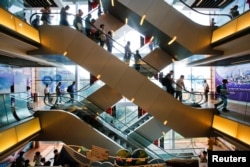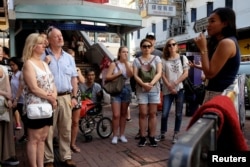On a recent Sunday afternoon, thousands of shoppers crowded the hallways and stores of the Citygate Outlets shopping mall in Tung Chung, one of Hong Kong’s new town developments just a short train ride from the airport.
Some visitors had recently arrived by plane, wheeling luggage with baggage claim tags, although thousands more came for short trips by bus over the newly opened 34-mile mega bridge connecting Tung Chung with Macau, another semi-autonomous Chinese city, and Zhuhai in mainland China.
Many of the bridge tourists arrive in large groups with the help of tour bus operators, like Akira Liu from Foshan in southern China, who had ferried a group of 30 across the bridge to Tung Chung for the day.
“Many of our tourists just want to cross the bridge and see the bridge, since our groups consists mostly of old people,” she said.
While Citygate Outlets has long been popular with visitors, the mall and other areas around Tung Chung became the latest political flashpoint in Hong Kong late last year as tourist numbers surged following the opening of the bridge. More than 1 million people crossed the bridge in November alone, according to figures from the Census and Statistics Department, although it fell to around 740,000 last month.
Tourists taking over
The government has welcomed the arrival of these new visitors with open arms, but for many residents, the city seems to be suffering from the same curse as other global tourism hotspots like Edinburgh and Venice: too many visitors taking over the city.
In places like Tung Chung, a residential neighborhood of large apartment blocks once valued for its quiet, many residents were simply unprepared for the new influx, with visitors swamping spots popular with residents like pharmacies and restaurants in addition to shopping malls.
“The daily lives of Tung Chung residents have been greatly affected,” Louis Poon, a community officer with the pro-establishment political group Roundtable said via email. “They are plagued by overcrowding, littering and long queues. For example, shops are so crowded with tourists, who sit everywhere … also it is hard to even walk past the shopping center. Most public areas are taken by the tourists.”
Roundtable is not the only group that has been vocal about overcrowding. Following a number of protests and public outcry over Tung Chung, the Guangdong and Hong Kong governments have pledged to crack down on illegal tours, according to the Tourism Bureau, while new shops are being set up on one of the bridge’s artificial islands to offset demand across the border.
Tourist dollars add up
But the government has not taken measures to curb citywide tourism, which hit 65 million visitors last year in an area roughly the size of metropolitan New York. The visitors, the vast majority of whom come from China, bring in billions in revenue, roughly $38 billion in 2017, and tourism-related activities employ around 800,000 people, according to Tourism Board figures.
Overcrowding, however, has become a constant complaint beyond Tung Chung, particularly during China’s “golden week” holidays, when most of the nation goes on vacation for a week three times a year.
During the summer months, as well, local media often carry complaints of Chinese tourists flooding beach campsites and sports programs to the irritation of locals, with many paying “tour groups” like Ctrip in the mainland for the privilege of using Hong Kong’s public facilities.
Further anti-Chinese feelings have arisen in some sectors of Hong Kong, particularly among the pro-democracy camp, for what it sees as Beijing’s political and legal encroachment on the former British colony, which was promised autonomy until 2047 when it returned to Chinese sovereignty.
Resentment at the growing tide of Chinese visitors has not gone unnoticed. Citygate shopper Benny Xu from Shanghai said while she has been regularly visiting Hong Kong for a decade, she has noticed a change in treatment in the past three years, particularly when she speaks Mandarin in lieu of the local language, Cantonese.
“Over 10 years ago, they were very warm, but now it’s a little bit changed. Some attitudes are not so good,” she said. “In the shops or restaurants and some public areas, they are not offering to speak Mandarin, they just speak Cantonese or English. If I spoke Mandarin, they are a little bit rude.”










